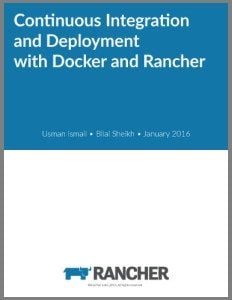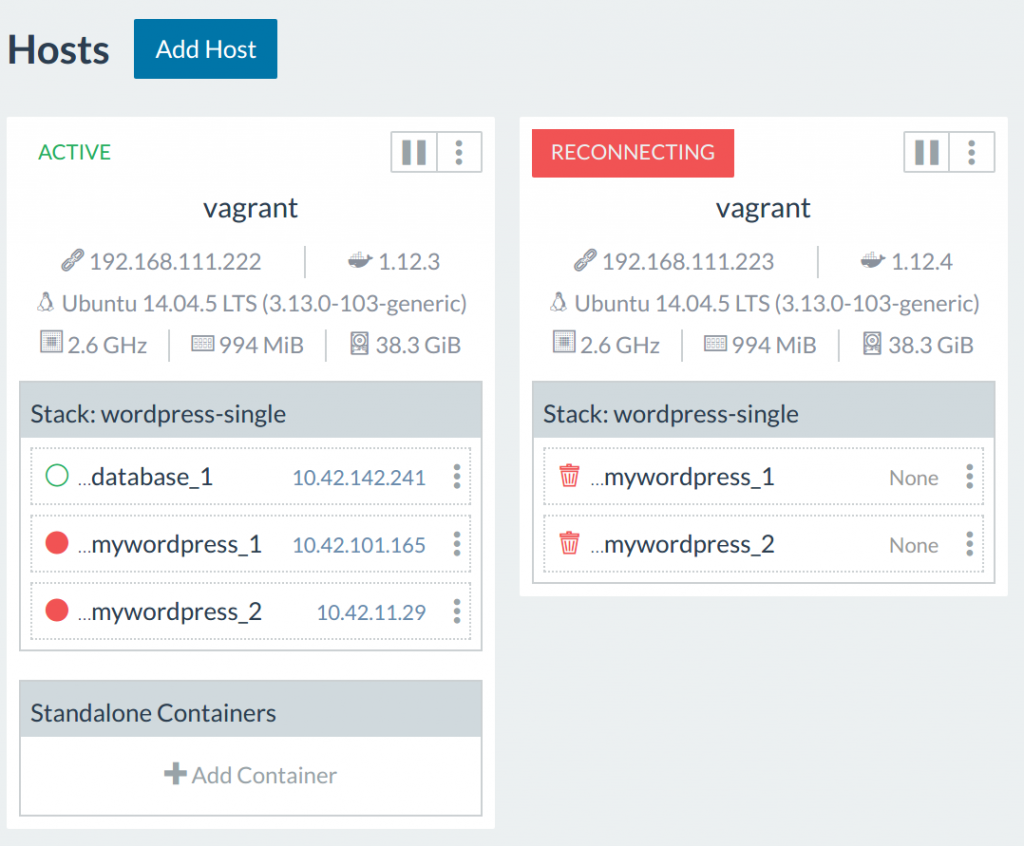Resilient Workloads with Docker and Rancher: Part 5
This is the last part in a series on designing resilient containerized
workloads. In case you missed it, Parts 1, 2, 3, and 4 are already
available online. In Part 4 last week, we covered in-service and
rolling updates for single and multiple hosts. Now, let’s dive into
common errors that can pop up during these updates:
Common Problems Encountered with Updates
Below is a brief accounting of all the supporting components required
during an upgrade. Though the Rancher UI does a great job of presenting
the ideal user experience, it does hides some of the complexities that
occur with operating container deployments in production: 
The blue indicates parts of the system under control by Rancher. The
types of bugs that exist on this layer require the end user to be
comfortable digging into Rancher container logs. We briefly discussed
ways to dig into Rancher networking in Part
2.
Another consideration is scaling Rancher Server along with your
application size; since Rancher writes to a relational database, the
entire infrastructure may be slowed down by I/O and CPU issues as
multiple services are updated. The yellow parts of the diagram indicate
portions of the system managed by the end user. This requires some
degree of knowledge of setting the infrastructure hosts up for
production. Otherwise, a combination of errors in the yellow and blue
layers will create very odd problems for service upgrades that are very
difficult to replicate. Broken Network to Agent Communication
 Free
Free
eBook: Continuous Integration and Deployment with Docker and
Rancher Suppose I shutoff my node2 (the one with my
Wordpress containers). How does a lost host affect the ability of
Rancher to coordinate?
$> vagrant halt node2
Rancher did not automatically migrate my containers, because there was
no health check in place – we need to establish a
health-check to
have the containers automatically migrate. With a health-check in place,
our ‘mywordpress’ service will automatically migrate to other hosts.
In this case, our application went down because the load balancer on
node1 was unable to route traffic to services on node2. Since our
application utilizes a HAProxy load balancer that is dynamically
configured by Rancher, this problem is a combination of problems with
user- and Rancher-managed networking. In this setting, though the app
sees downtime, an upgrade still works as expected:
$> rancher-compose up --upgrade --force-upgrade
Rancher starts the containers on the node1 (which is reachable) and then
marks node2 as being on reconnecting state:

Agent on Host Unable to Locate Image Suppose now that I have a
custom repository for my organization. We will need to add a registry to
the Rancher instance to pull custom images. A host node might not have
access to my custom registry. When this occurs, Rancher will
continuously attempt to maintain the scale of the service and keep
cycling the containers. Rancher does this by allowing all agents to add
various Docker registries in
Rancher.
The credentials are kept on the agents and are not available to the
host. Sometimes, it is also important to check if a host node has access
to the registry. A firewall rule or a IAM profile misconfiguration on
AWS may cause your host to fail to pull the image, even with proper
credentials. This is a issue where errors most commonly reside in the
yellow user-controlled infrastructure. Docker on Host Frozen Running
a resilient Docker host is a technical challenge in itself. When using
Docker in a development capacity, all that was required was installing
Docker engine. In production, the Docker engine requires many
configuration options, such as the production OS, the type of storage
driver to
be used, and how much space to allocate to the Docker daemon, all of
which play a part in the user-controlled environment. Managing a
reliable Docker host layer carries problems similar those in traditional
hosting: both require maintaining up-to-date software on bare metal.
Since the Rancher agent directly interfaces with the Docker daemon on
the host, if the Docker daemon is unresponsive, then Rancher components
have little control over this component. An example of when a Docker
daemon failure prevents a rollback is when the old containers reside on
one host, but the Docker daemon freezes up. This usually requires the
daemon or host to be force rebooted. Sometimes the containers will be
lost, and our rollback candidates are purged.
Problems with In Service Deployment
A short list of issues we encountered or discussed in our experiments:
- Port conflicts
- Service State issues
- Network Routing issues
- Registry Authentication issues
- Moving Containers
- Host issues
In summary, in-service deployment suffer from the following issues:
- Unpredictable under failure scenarios
- Rollbacks don’t always work
If you like to dig more into CI/CD theory, you can continue your deep
dive with an exert from the CI/CD
Book.
In general, we can have confidence that stateless application containers
behind load balancers (like a node app or WordPress) can be quickly
redeployed when needed. However, more complex stacks with interconnected
behavior and state require a new deployment model. If the deployment
process is not exercised daily in a CI/CD process, an ad-hoc in-place
update may surface unexpected bugs, which require the operator to dig
into Rancher’s behavior. Coupled with multiple lower layer failures,
this may make upgrading more complicated applications a dangerous
proposition. This is why we introduce the blue-green deployment method.
Blue-Green Deployment
With in-place updates having so many avenues of failure, one should only
rely on it as part of CI/CD pipeline that exercises the updates in a
repeatable fashion. When the deployment is regularly exercised and bugs
are fixed as they arise, the cost of deployment issues is negligible for
most common web-apps and light running services. But what if it is a
stack due for update is rarely touched? Or the stack that requires many
complex data and network interactions? A blue-green deployment pattern
creates breathing space to more reliably upgrade the stack.
The Blue-Green Deployment
Section of
the CI/CD book details how to leverage internet routing to redirect
traffic to another stack. So instead of keeping traffic coming into a
service or stack while it is updating, we will make upgrades in a
separate stack and then adjust the DNS entry or proxy to switch over the
traffic.

Once the blue stack is updated, we will update the load-balancer to
redirect traffic to the green stack. Now our blue stack has become our
staging environment, and we make changes and upgrades there until the
next release. To test such a stack, we deploy a new stack of services
that is only load-balancers. We set it as a global service, so it will
intercept requests at port :80 on each host. We will then modify our
Wordpress application to internal port :80, so no conflicts occur.

We then clone this setup to another stack, and call it
wordpress-single-blue.
mywordpress:
tty: true
image: wordpress
links:
- database:mysql
stdin_open: true
database:
environment:
MYSQL_ROOT_PASSWORD: pass1
tty: true
image: mysql
volumes:
- '/data:/var/lib/mysql'
stdin_open: true
wordpresslb:
# internal load balancer
expose:
- 80:80
tty: true
image: rancher/load-balancer-service
links:
- mywordpress:mywordpress
stdin_open: true
.
.
.
wordpresslb:
image: rancher/load-balancer-service
ports:
# Listen on public port 80 and direct traffic to private port 80 of the service
- 80:80
external_links:
# Target services in a different stack will be listed as an external link
- wordpress-single/wordpresslb:mywordpress
# - wordpress-single-blue/wordpresslb:mywordpress
labels:
- io.rancher.scheduler.global=true
Summary of Deployments on Rancher
We can see that using clustered environments entails a lot of
coordination work. Leveraging the internal overlay network and various
routing components to support the containers provides flexibility in how
we maintain reliable services within Rancher. This also increases the
amount of knowledge needed to properly operate such stacks. A simpler
way to use Rancher would be to lock environments to specific hosts with
host tags. Then we can schedule containers onto specific hosts, and use
Rancher as a Docker manager. While this doesn’t use all the features
that Rancher provides, it is a good first step to ensure reliability,
and uses Rancher to model a deployment environment that you are
comfortable with. Rancher supports container scheduling policies that
are modeled closely after Docker Swarm. In an excerpt from the Rancher
documentationon
scheduling, they include scheduling based on:
- port conflicts
- shared volumes
- host tagging
- shared network stack: ‘net=container:dependency
- strict and soft affinity/anti-affinity rules by using both
environment variables (Swarm) and labels (Rancher)
You can organize your cluster environment however that is needed to
create a comfortable stack.
Supporting Elements
Since Rancher is a combination of blue Rancher manged components, and
yellow end user managed components. We want to pick robust components
and processes to support our Rancher environment. In this section, we
briefly go through the following:
- Reliable Registry
- Encoding Services for Repeatable Deployments
- Reliable Host
Reliable Registry First step is to get a reliable registry, a good
reading would be to look at the requirements to setup your own private
registry on
the Rancher blogs. If you are unsure there may be interest in taking a
look at Container Registries You Might Have
Missed. This
article evaluates registry products, and can be a good starting point
for picking out a registry for your use cases. Though, to save on some
mental clutter, we recommend taking a look at an excellent article on
Amazon Elastic Container Registry (ECR) called Using Amazon Container
Registry
Service.
AWS ECR is a fully managed private docker registry. It is cheap (S3
storage prices) and provides fine grained permissions controls.
Caveat, be sure to use a special container tag for production, e.g.
:prod, :dev, :version1. Sometimes with multiple builds, we would like to
avoid one developer builds overwriting the same :latest tag.
Encoding Services for Repeatable Deployments We have been encoding
our experiments in compose files over the past few blog posts. Though
the docker-compose.yml and rancher-compose.yml sections are
great for single services, we can extend this to a large team through
the use of Rancher catalogs. There is an Article Chain on Rancher
Catalog
Creation and
the documentation for Rancher
catalogs. This will
go hand in hand with the Blue-Green deploy method, as we can just start
a new catalog under a new name, then redirect our top level loadbalancer
to the new stack. Reliable Hosts Setting up a Docker host is also
critical. For development and testing, using the default Docker
installation is enough. Docker itself has many resources, in particular
a commercial Docker engine and a compatibility
matrixfor
known stable configurations. You can also use Rancher to create AWS
hosts for you, as Rancher provides an add-host feature that provisions
the agent for you, this can be found in the
documentation.
Building your own hosts allows for some flexibility for more advanced
use cases, but will require some additional work from the user-end. In a
future article, we will take a look at how to setup a reliable docker
host layer, as part of a complete Rancher deployment from scratch.
Summary
Now we have a VM environment that can be spun up with Vagrant to test
the latest Rancher. It should be a great first step to test out
multi-node Rancher locally to get a feel for how the upgrades work for
your applications. We have also explored the layers that support a
Rancher environment, and highlighted parts that may require additional
attention such as hosting and docker engine setup. With this, we hope
that we have provided a good reading guide into what additional steps
your infrastructure needs prior to a production deployment. Nick Ma is
an Infrastructure Engineer who blogs about Rancher and Open Source. You
can visit Nick’s blog, CodeSheppard.com, to
catch up on practical guides for keeping your services sane and reliable
with open-source solutions.
Related Articles
Sep 20th, 2023
What is new in Rancher Desktop 1.10
Mar 14th, 2023